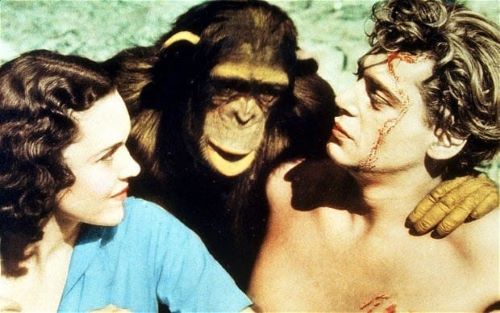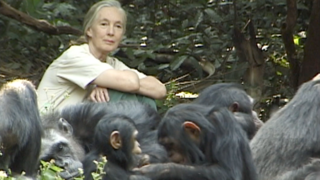What is Speciesism?
Is Speciesism important?
Chimps, Roosters & Humankind…

Animal Rights & Speciesism: Chimps, Roosters & Humankind
“And I would read up there, in my own leafy and private world. I think I went through all the Tarzan books thirty feet or so above the ground. I was madly in love with the Lord of the Jungle, terribly jealous of his Jane. It was daydreaming about life in the forest with Tarzan that lead to my determination to go to Africa. To live with animals and write books about them.” – Jane Goodall, REASON FOR HOPE: A Spiritual Journey.
For many of us Boomers, our introduction to Chimpanzees was in the old Tarzan movies.
Cheeta (based on Nkima the monkey in Edgar Rice Burroughs’ stories) was a tame, comical companion who readily sought out help when a human was in trouble. A primate version of Lassie and Rin Tin Tin. And we loved them all.
Hints of Speciesism: It was only later that we discovered unpleasant truths.
Tarzan actors like Jock Mahoney and Mike Henry reported bad tempered chimps who bit and scratched.
“I’m glad the chimp’s gone,” said Jock, “They’re the dirtiest, meanest animals to work with.” Mike would describe his own Chimp Attack while filming TARZAN AND THE GREAT RIVER: “I was to run over to the chimp and pick him up. When I did, he lashed out at me and ripped my jaw open. It took twenty stitches to put my face back together. I was in a monkey-fever delirium for three days…” [1]
And we learned that the movie and TV chimps were juveniles, often snatched from their mothers as babies. Adult chimpanzees were MUCH bigger and independent — and kept off-screen.
Then came Jane Goodall.

With books like MY FRIENDS THE WILD CHIMPANZEES, INNOCENT KILLERS and IN THE SHADOW OF MAN, Jane gave us phenomenal glimpses into the world of our relatives.
What nature writers like Jane Goodall and Farley Mowat and Dian Fossey told us is what some of us already secretly knew: our wild companions were both vastly different from us and yet so much alike. The concepts of Animal Rights and Speciesism were unleashed.
Here, from Miriam Jones, is a guest blog exploring some of the latest thoughts on Speciesism.
“Chimps, Chickens and Communication” a Guest Blog by Miriam Jones
A new study published in Current Biology proves (as if more evidence were needed) that, in the words of zoologist Matthew Cobb, “Humans aren’t quite so unique, after all.” The so-called news is that chimps will warn other chimps about a hazard if and only if the other chimps don’t already know about the danger.
This adds to the evidence that chimps not only use sound-symbols to convey meaning, as we do, but also that they have what psychologists call theory of mind: an awareness that others have mental states (such as knowing something or not) different than one’s own.
Chickens are similarly flexible in their production of and responses to alarm cries.
When a rooster spots a hawk or other potential predator in the sky, he shouts a sound-symbol that actually sounds a lot like the word HAWK. Everybody runs for cover without delay. Other roosters shout too, whether or not they’ve seen the threatening shadow in the sky. Hens join in, clucking in low foreboding tones. Nobody shuts up or steps back out into the open until the rooster who raised the original warning crows an “All Clear” signal.
In contrast, if a rooster spots a fox or other potential predator on the ground, he makes a different warning sound. Then, everybody stops moving and looks around. The calls of roosters, then, are what researchers call functionally referential, encoding sufficient information about the circumstances of production for conspecifics to respond appropriately, even in the absence of contextual cues potentially provided by the non-vocal behavior of the sender.
None of this is surprising, eh?
The ancestors of modern chickens evolved in the jungles of South Asia, where flocks did (and still do) forage amid dense foliage that prevents them from maintaining visual contact. Such circumstances presumably led to the development of language among our own ancestors. It’s only human hubris that leads us to be surprised when other animals turn out to have utilized some of the same strategies for survival as we did.
And so we demand proof. And so scientists set up studies.
The good news is that, in the case of the chimps, the researchers did not significantly interfere with the animals or their habitat in order to collect their data. They merely placed a replica of a poisonous viper along a path frequented by chimps and watched what happened. Since watching out for, avoiding, and warning others about such environmental hazards is part of the everyday lives of those chimps, that was a relatively unobtrusive way to learn something about them. It’s still scaring somebody to study their reaction but, given that such scares are an everyday occurrence in the lives of free-living animals, probably not injurious.
That’s not the case with the study of rooster alarm cries, which was done by researchers who have repeatedly used laboratory experiments to demonstrate that chickens have communications capacities far more sophisticated than most people presume.
Raising, yet again, the question of what these scientists might be thinking about their own right to experiment on these sentient beings.
Ironically, research concerning the capabilities of chimpanzees helped to supply some of the data leading the U.S. to suspend funding for any new bio-medical research using chimps as subjects. Anybody who has read about any of the horrific experiments to which chimpanzees have been subjected has to cheer that decision. At the same time, that and other bans or limitations on the use of great apes as research subjects often depend on the argument that, because they are closest to us, great apes are so superior to other animals as to be exempt.
Chickens are also exempt, but in a different way. Rodents and birds are specifically exempted from the animal welfare regulations that minimally mitigate the suffering that can be inflicted upon animals used in research.
Some activists, such as Ingrid Newkirk of PETA, argue that any regulation that in any way establishes any sort of right for any animal represents a crack in the foundation of the justification of human exploitation of animals. Over time, the theory goes, those cracks will bring the building down. Others argue that protecting some animals, but not others, leaves the structure unchallenged, especially when the justification for special protection is that the protected animal is especially “like us.”
What do you think?
Miriam Jones has been active in one social justice movement or another since she was a teenager doing feminist and LGBT activism.
In 2000, Miriam Jones co-founded the Eastern Shore Chicken Sanctuary with pattrice jones. For nine years, the organization existed on the Lower Eastern Shore of Maryland — Perdue country — saving the lives of thousands of chickens and spreading the word about speciesism and the importance of ending the human domination of non-human animals.
During this time, the organization also pioneered a method by which fighting roosters might be helped to stop fighting, and since that time, has helped almost 100 roosters learn to live peacefully with other chickens. In 2009, the Eastern Shore Sanctuary became VINE Sanctuary (Veganism Is the Next Evolution) when it moved to Vermont.
http://www.bravebirds.org
Today, Miriam acts as the Administrative Coordinator for the organization, which offers sanctuary to about 450 animals, including cows, sheep, chickens (including former fighting cocks), emus, geese, ducks, turkeys, parakeets, doves, and pigeons.
==>> To Read More On This Subject, Go To Animal Rights, Circuses, Tarzan & PETA XXX
==>> To See More About Tarzan and His Creator, Go To EDGAR RICE BURROUGHS: A Tribute to Tarzan’s Creator
[1] THE GREAT SHOW BUSINESS ANIMALS by David Rothel, A S Barnes & Company, New York, 1980
“As sentient beings, Chimpanzees should not be treated as property.” Steven Wise, President of Nonhuman Rights Project












